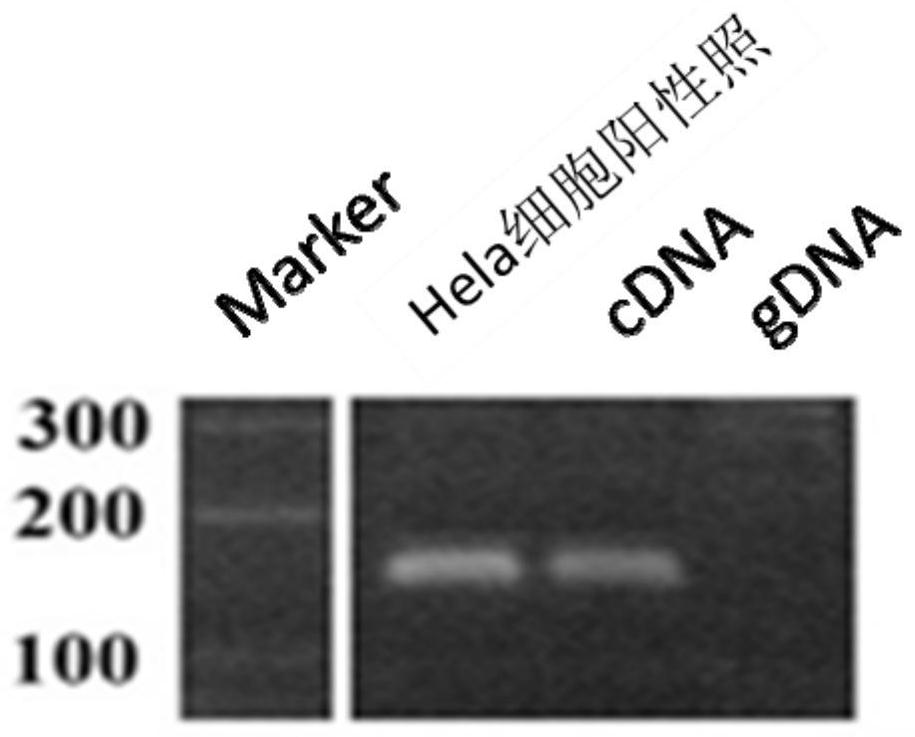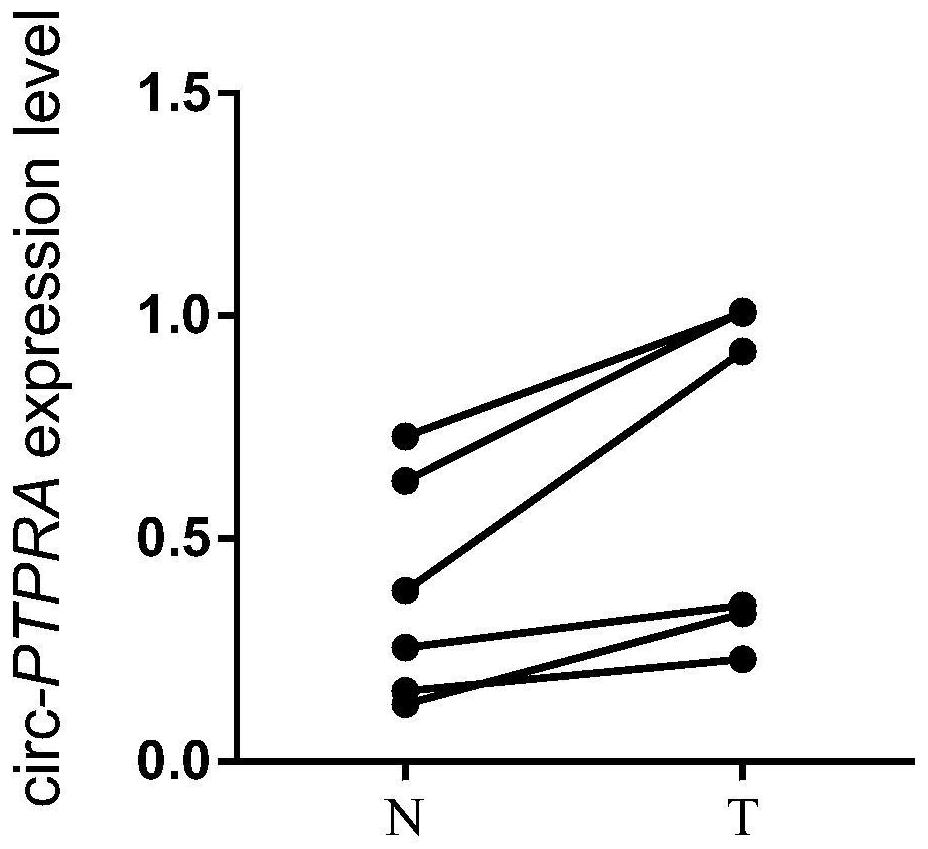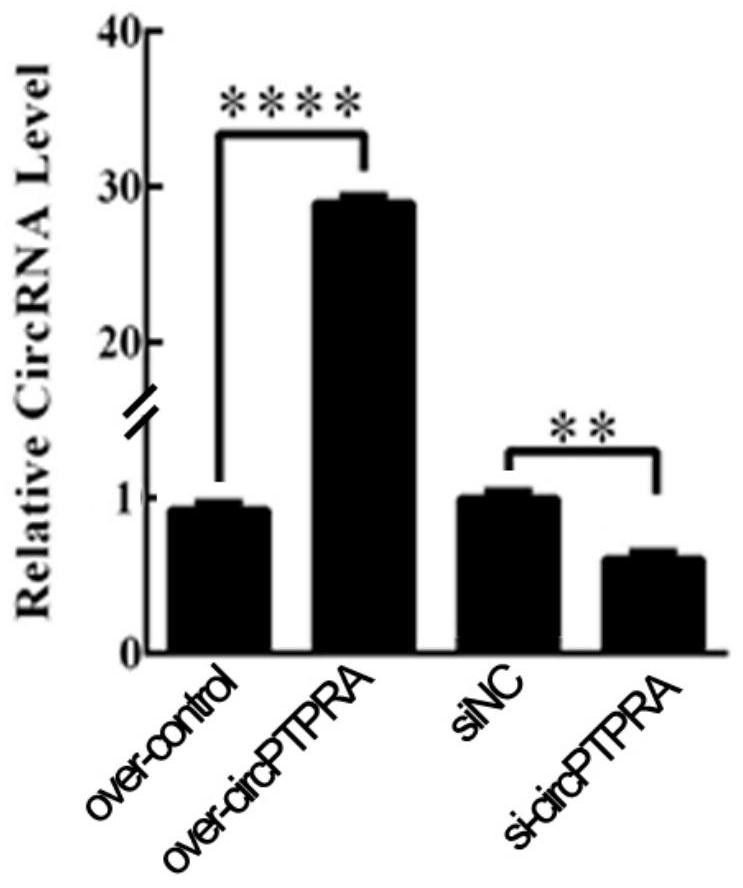Uses of circular RNA circ-PTPRA
A circular and versatile technology, applied in the fields of molecular biology and oncology, can solve the problems of pancreatic cancer without research, and achieve the effect of increasing cell growth rate, increasing apoptosis level, and reducing growth rate
- Summary
- Abstract
- Description
- Claims
- Application Information
AI Technical Summary
Problems solved by technology
Method used
Image
Examples
Embodiment 1
[0032] Example 1: RT-PCR reaction detection of circ-PTPRA gene expression in pancreatic cancer tissue.
[0033] The specific experimental plan is as follows:
[0034] 1. RNA extraction
[0035] 1) Tissue processing: Take about 10 mg of tissue and add 1 mL of Trizol, homogenize with a homogenizer; centrifuge for 15 minutes at 12,000 g, and take the supernatant.
[0036] 2) Add 200 μL of chloroform to the supernatant, mix vigorously up and down for half a minute, and let stand for 3 minutes.
[0037] 3) Centrifuge at 12,000g for 15 minutes at 4°C. At this time, it can be seen that the lysate is divided into three layers: the upper layer is RNA in the aqueous phase; the middle layer is DNA, lipids, etc.; the lower layer is cell residues, proteins, polysaccharides, etc.
[0038] 4) Take the supernatant into a new EP tube; add an equal volume of isopropanol, mix well, let stand for 10 minutes, and then centrifuge at 12000g for 10 minutes at 4°C.
[0039] 5) Carefully remove the ...
Embodiment 2
[0055] Example 2: Detection of circ-PTPRA expression in pancreatic cancer by QPCR
[0056] 1, RNA extraction: with embodiment 1;
[0057] 2. cDNA reverse transcription: same as Example 1;
[0058] 3. QPCR amplification experiment
[0059] 1) Experimental system:
[0060]
[0061] 2) Reaction conditions:
[0062] Step 1: 95°C for 2 minutes
[0063] Step 2 (40 cycles): 95°C for 3 seconds, 60°C for 30 seconds
[0064] The third step 60 ~ 95 ℃ melting curve
[0065] 3) Amplify the target gene on the machine
[0066] 4) qPCR relative quantitative results
[0067] The formula for calculating the relative expression of the target gene is: 2-△△Ct=2-[(△Ct)Test-(△Ct)Control]. Ct object is the Ct value of the target gene, and Ct housekeeper is the Ct value of the housekeeping gene. △Ct=Ct Purpose-Ct Housekeeper, indicating the relative Ct value of the target gene of each sample relative to the housekeeping gene, △△Ct=(△Ct)Test-(△Ct)Control, indicating that the treatment group...
Embodiment 3
[0068] Example 3: Construction of circ-PTPRA interference fragment and overexpression plasmid
[0069] 1. Design of circ-PTPRA interference fragment: siRNA sequence was synthesized in Shanghai Gemma Company. The nucleotide sequence of the siRNA sense strand of circ-PTPRA is shown in SEQ ID NO:4, and the nucleotide sequence of the antisense strand is shown in SEQ ID NO:5. The nucleotide sense strand sequence of the Control negative control is shown in SEQ ID NO:6, and the antisense strand sequence is shown in SEQ ID NO:7.
[0070] 2. Overexpression plasmid construction: Synthesize the complete linear sequence of circ-PTPRA, anneal the sequence into a double-stranded DNA fragment, and insert it into the LV-Circ vector through multiple cloning sites. The recombinant plasmid is identified by sequencing, and the Control negative control is the uninserted sequence The LV-Circ empty vector.
[0071] 3. Interference and overexpression efficiency verification:
[0072] 1) After the ...
PUM
 Login to View More
Login to View More Abstract
Description
Claims
Application Information
 Login to View More
Login to View More - Generate Ideas
- Intellectual Property
- Life Sciences
- Materials
- Tech Scout
- Unparalleled Data Quality
- Higher Quality Content
- 60% Fewer Hallucinations
Browse by: Latest US Patents, China's latest patents, Technical Efficacy Thesaurus, Application Domain, Technology Topic, Popular Technical Reports.
© 2025 PatSnap. All rights reserved.Legal|Privacy policy|Modern Slavery Act Transparency Statement|Sitemap|About US| Contact US: help@patsnap.com



